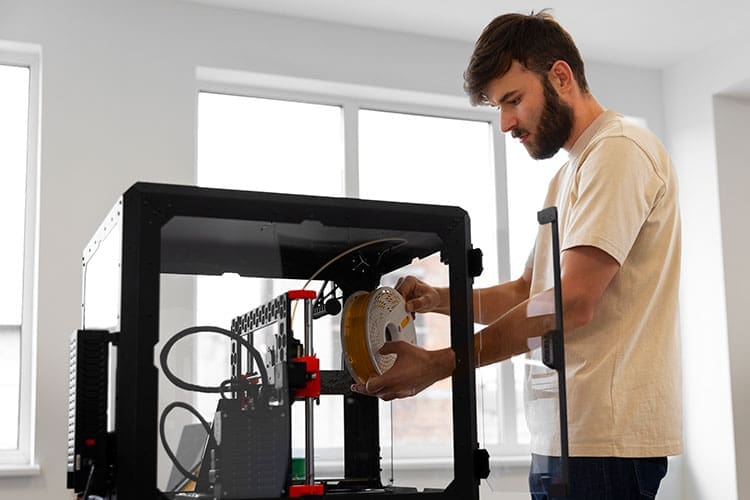How 3D Printing is Revolutionizing the Bike Industry
The Impact of 3D Printing on Bike and Product Development
Historically, the bicycle has maintained a simple design: two triangular frames, two circular wheels, and essential parts for acceleration, braking, and steering. Despite minimal changes to this basic structure since the late 19th century, there has been continual innovation in component design and materials, evolving from steel to aluminium, carbon fiber, titanium, and beyond.
However, we may be entering a transformative era with the advent of 3D printing technology. Already, the market has seen a surge of products, including 3D-printed bike accessories like custom saddles and parts tailored for professional cyclists like SoCalCycling.com readers, and even complete 3D-printed bike frames.
But is 3D printing a viable alternative to traditional manufacturing? What does it herald for the future of cycling technology?
Understanding 3D Printing
3D printing, also known as additive manufacturing, builds a product layer by ultra-thin layer from a 3D CAD model. Unlike CNC machining, which subtracts material, 3D printing adds material precisely where needed, starting with a thin layer of metal powder spread across a print bed, followed by a laser that solidifies the design. This method allows for complex geometries and intricate details that would be difficult or impossible to achieve with traditional manufacturing. The versatility of 3D printing extends to a variety of materials, including plastics, composites and resins, such as the Formlabs resin printer.
Material Diversity and Flexibility
3D printing offers an expansive range of materials that can be used, from durable metals to flexible polymers and composite materials. This flexibility allows for the creation of parts that are tailored to specific functional requirements, such as lightweight frames for 3D-printed bikes or durable 3D-printed bike parts. Each material brings distinct properties that enhance the product’s utility and performance.
Precision and Customization
One of the standout features of 3D printing is its ability to produce highly customized products with precision. This is particularly beneficial in the cycling industry, where ergonomic and anatomical considerations are paramount. 3D-printed bicycle parts can be designed to fit individual riders perfectly, enhancing comfort and performance. This level of customization is unmatched by traditional manufacturing methods.
Sustainability and Waste Reduction
3D printing is also recognized for its potential in promoting sustainability. The additive process minimizes waste by using only the necessary amount of material required to build a part, contrasting with subtractive methods that cut away significant portions of raw material. Furthermore, the ability to print on demand helps reduce overproduction and excess inventory, aligning with more eco-friendly production practices.
Benefits of 3D Printing in Cycling
The prototyping potential of 3D printing is particularly beneficial. It allows designers to create and adjust parts on a computer and directly produce them without the cost of molds or tooling. This capability dramatically speeds up development and enables rapid iterations, an advantage utilized by companies like Fizik and athletes such as Geraint Thomas, who tested 3D-printed bike parts during competitive events.
Custom components, such as the 3D-printed time trial extensions used by top cyclists and uniquely designed items for specific applications, underscore 3D printing’s utility in producing highly specialized 3D-printed bike accessories and parts.
Scaling Production with 3D Printing
Beyond prototyping, 3D printing is increasingly used in full-scale production. Products range from the visually striking Mythos Elix stem to more subtle components like Silca’s titanium cleats, which leverage 3D printing to optimize the strength-to-weight ratio. Atherton Bikes, for example, integrates 3D-printed carbon fiber bike components designed to handle complex loads more effectively than traditional materials. This technology enables manufacturers to quickly adapt designs and reduce waste, enhancing sustainability. The ability to produce small batches economically also opens up opportunities for customization and innovation in design, further pushing the boundaries of what is possible in manufacturing.
Lowering Barriers and Enhancing Flexibility
3D printing also reduces entry barriers for smaller manufacturers by minimizing the need for large upfront investments in tooling and inventory. This technology allows for local, on-demand production, which is more sustainable and responsive to market changes.
Examples of how 3D printing enhances flexibility and reduces barriers:
- Custom Component Production: Small-scale manufacturers can produce custom or niche components without the high costs associated with traditional manufacturing setups.
- Rapid Prototyping: Businesses can quickly develop and refine products, significantly reducing the time from concept to market.
- Decentralized Manufacturing: Companies can set up smaller, localized production units closer to the end consumers, reducing shipping times and costs.
- Reduced Inventory Needs: Manufacturers can produce goods on demand, avoiding the expense and space required for large inventories.
- Sustainability: Local production reduces the carbon footprint associated with transporting goods over long distances, contributing to environmental sustainability.
Limitations and Future Prospects
Despite its advantages, 3D printing is not without challenges. It is generally slower and more labor-intensive than traditional manufacturing, and the costs of materials and equipment remain high. However, as the technology advances and becomes more accessible, these obstacles are likely to diminish. Additionally, the ongoing development of faster and more efficient printers could revolutionize production speed. Furthermore, as the market for 3D-printed products grows, economies of scale may reduce material costs, making the technology more competitive with conventional manufacturing methods.
Conclusion
As 3D printing continues to develop, its impact on the cycling industry is expected to grow, potentially making traditionally manufactured bikes and components obsolete. With ongoing improvements and a decrease in production costs, 3D-printed bikes and 3D-printed bicycle parts are set to become more prevalent, offering unprecedented customization and efficiency in bike manufacturing.
This shift not only promises enhanced performance and tailored designs for cyclists but also signifies a significant move towards more agile and innovative manufacturing practices within the industry.
No products found.


















